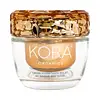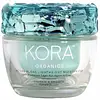What's inside
What's inside
 Key Ingredients
Key Ingredients

 Benefits
Benefits

 Concerns
Concerns

 Ingredients Side-by-side
Ingredients Side-by-side

Aloe Barbadensis Leaf Juice
Skin ConditioningGlycerin
HumectantCoconut Alkanes
EmollientCetearyl Alcohol
EmollientPersea Gratissima Oil
Skin ConditioningRosa Canina Seed Oil
EmollientBalanites Roxburghii Seed Oil
Skin ConditioningWater
Skin ConditioningLactobacillus Ferment
Skin ConditioningCetearyl Olivate
Helianthus Annuus Seed Oil
EmollientSorbitan Olivate
EmulsifyingButyrospermum Parkii Butter
Skin ConditioningHippophae Rhamnoides Fruit Oil
Skin ProtectingPassiflora Edulis Seed Oil
EmollientCaprylic/Capric Triglyceride
MaskingOryza Sativa Extract
AbsorbentLactobacillus
Skin ConditioningAscorbyl Glucoside
AntioxidantCoco-Caprylate/Caprate
EmollientLactobacillus/Arundinaria Gigantea Leaf Ferment Filtrate
Skin ConditioningAstrocaryum Murumuru Seed Butter
EmollientGossypium Herbaceum Seed Oil
Skin ConditioningSaccharomyces Lysate Extract
HumectantBidens Pilosa Extract
HumectantCalendula Officinalis Flower Extract
MaskingCocos Nucifera Fruit Extract
EmollientPotassium Sorbate
PreservativeLavandula Angustifolia Oil
MaskingLinum Usitatissimum Seed Oil
PerfumingLactic Acid
BufferingPhospholipids
Skin ConditioningCitrus Limon Peel Oil
MaskingHydrolyzed Sodium Hyaluronate
Skin ConditioningMentha Piperita Oil
MaskingSclerotium Gum
Emulsion StabilisingPotassium Hydroxide
BufferingCurcuma Longa Root Extract
MaskingGlycyrrhiza Glabra Root Extract
BleachingMorinda Citrifolia Fruit Extract
Skin ConditioningYogurt Powder
Sodium Phytate
Cylindrotheca Fusiformis Extract
AntioxidantLeuconostoc/Radish Root Ferment Filtrate
AntimicrobialCananga Odorata Flower Oil
MaskingJuniperus Virginiana Oil
MaskingLeuconostoc Ferment Filtrate
AntimicrobialTocopherol
AntioxidantBisabolol
MaskingSoybean Peroxidase
AntioxidantSuperoxide Dismutase
AntioxidantAlcohol
AntimicrobialCitral
PerfumingGeraniol
PerfumingLimonene
PerfumingLinalool
PerfumingAloe Barbadensis Leaf Juice, Glycerin, Coconut Alkanes, Cetearyl Alcohol, Persea Gratissima Oil, Rosa Canina Seed Oil, Balanites Roxburghii Seed Oil, Water, Lactobacillus Ferment, Cetearyl Olivate, Helianthus Annuus Seed Oil, Sorbitan Olivate, Butyrospermum Parkii Butter, Hippophae Rhamnoides Fruit Oil, Passiflora Edulis Seed Oil, Caprylic/Capric Triglyceride, Oryza Sativa Extract, Lactobacillus, Ascorbyl Glucoside, Coco-Caprylate/Caprate, Lactobacillus/Arundinaria Gigantea Leaf Ferment Filtrate, Astrocaryum Murumuru Seed Butter, Gossypium Herbaceum Seed Oil, Saccharomyces Lysate Extract, Bidens Pilosa Extract, Calendula Officinalis Flower Extract, Cocos Nucifera Fruit Extract, Potassium Sorbate, Lavandula Angustifolia Oil, Linum Usitatissimum Seed Oil, Lactic Acid, Phospholipids, Citrus Limon Peel Oil, Hydrolyzed Sodium Hyaluronate, Mentha Piperita Oil, Sclerotium Gum, Potassium Hydroxide, Curcuma Longa Root Extract, Glycyrrhiza Glabra Root Extract, Morinda Citrifolia Fruit Extract, Yogurt Powder, Sodium Phytate, Cylindrotheca Fusiformis Extract, Leuconostoc/Radish Root Ferment Filtrate, Cananga Odorata Flower Oil, Juniperus Virginiana Oil, Leuconostoc Ferment Filtrate, Tocopherol, Bisabolol, Soybean Peroxidase, Superoxide Dismutase, Alcohol, Citral, Geraniol, Limonene, Linalool
Aloe Barbadensis Leaf Juice
Skin ConditioningGlycerin
HumectantHelianthus Annuus Seed Oil
EmollientIsoamyl Laurate
EmollientWater
Skin ConditioningTriheptanoin
Skin ConditioningGlyceryl Stearate Citrate
EmollientChlamydomonas Reinhardtii Extract
HumectantCoco-Caprylate/Caprate
EmollientPolyglyceryl-3 Stearate
EmulsifyingLactobacillus Ferment
Skin ConditioningHydrogenated Lecithin
EmulsifyingXylityl Sesquicaprylate
AntimicrobialLysolecithin
EmulsifyingSclerotium Gum
Emulsion StabilisingDilinoleic Acid/Butanediol Copolymer
Chlorophyllin-Copper Complex
AntioxidantLactobacillus
Skin ConditioningXanthan Gum
EmulsifyingPullulan
Potassium Sorbate
PreservativeCitric Acid
BufferingAnhydroxylitol
HumectantLecithin
EmollientTocopherol
AntioxidantMorinda Citrifolia Fruit Extract
Skin ConditioningCocos Nucifera Fruit Extract
EmollientPelargonium Graveolens Flower Oil
MaskingCamellia Sinensis Leaf Extract
AntimicrobialRhododendron Ferrugineum Extract
MaskingSilica
AbrasiveCastor Oil/Ipdi Copolymer
Ocimum Basilicum Oil
MaskingRosa Centifolia Flower Oil
MaskingAlcohol
AntimicrobialCitronellol
PerfumingGeraniol
PerfumingAloe Barbadensis Leaf Juice, Glycerin, Helianthus Annuus Seed Oil, Isoamyl Laurate, Water, Triheptanoin, Glyceryl Stearate Citrate, Chlamydomonas Reinhardtii Extract, Coco-Caprylate/Caprate, Polyglyceryl-3 Stearate, Lactobacillus Ferment, Hydrogenated Lecithin, Xylityl Sesquicaprylate, Lysolecithin, Sclerotium Gum, Dilinoleic Acid/Butanediol Copolymer, Chlorophyllin-Copper Complex, Lactobacillus, Xanthan Gum, Pullulan, Potassium Sorbate, Citric Acid, Anhydroxylitol, Lecithin, Tocopherol, Morinda Citrifolia Fruit Extract, Cocos Nucifera Fruit Extract, Pelargonium Graveolens Flower Oil, Camellia Sinensis Leaf Extract, Rhododendron Ferrugineum Extract, Silica, Castor Oil/Ipdi Copolymer, Ocimum Basilicum Oil, Rosa Centifolia Flower Oil, Alcohol, Citronellol, Geraniol
 Reviews
Reviews

Ingredients Explained
These ingredients are found in both products.
Ingredients higher up in an ingredient list are typically present in a larger amount.
Alcohol comes in many different forms. Different types of alcohol will have different effects on skin. This ingredient is usually an astringent alcohol.
These alcohols are drying on the skin. They may strip away your skin's natural oils and even damage your skin barrier. Astringent alcohols may also irritate skin.
Other types of astringent alcohols include:
According to the National Rosacea Society based in the US, you should be mindful of products with these alcohols in the top half of ingredients.
Any type of sanitizing product will have high amounts of alcohol to help kill bacteria and viruses.
Fatty alcohols come from plant oils such as coconut oil. These can help hydrate the skin and are non-irritating. Some fatty alcohols include cetyl and stearyl alcohol.
Learn more about AlcoholAloe Barbadensis Leaf Juice comes from leaves of the aloe plant. Aloe Barbadensis Leaf Juice is best known for helping to soothe sunburns. It is also anti-inflammatory, moisturizing, antiseptic, and can help heal wounds.
Aloe is packed with good stuff including Vitamins A, C, and E. These vitamins are antioxidants, which help fight free-radicals and the damage they may cause. Free-radicals are molecules that may damage your skin cells, such as pollution.
Aloe Barbadensis Leaf Juice also contains sugars. These sugars come in the form of monosaccharides and polysaccharides, folic acid, and choline. These sugars are able to help bind moisture to skin.
It also contains minerals such as calcium, 12 anthraquinones, fatty acids, amino acids, and Vitamin B12.
Learn more about Aloe Barbadensis Leaf JuiceCoco-Caprylate/Caprate is created from fatty coconut alcohol, caprylic acid, and capric acid.
It is a lightweight emollient. Emollients create a thin barrier on the skin to trap moisture in. This helps keep your skin hydrated and soft.
Once applied, Coco-Caprylate/Caprate is absorbed quickly and leaves a silky feel.
Coco-Caprylate/Caprate may not be fungal acne safe.
Learn more about Coco-Caprylate/CaprateCocos Nucifera Fruit Extract comes from the meat of the coconut fruit. It is an emollient and skin conditioner with antioxidant properties.
Coconut fruit is naturally rich in amino acids, sugars, and nutrients including Vitamin C and small amounts of vitamin B. Malic acid can also be found in coconut fruit extract.
Geraniol is used to add fragrance/parfum to a product. It is the main component of citronellol. It is a monoterpenoid and an alcohol.
Monoterpenes are naturally found in many parts of different plants.
Geraniol can be found in many essential oils including Rose Oil and Citronella Oil. The scent of Geraniol is often described as "rose-like". Many foods also contain Geraniol for fruit flavoring.
Geraniol can irritate the skin when exposed to air. However, irritation depends on the ability of geraniol to penetrate into the skin. In general, geraniol is not able to penetrate skin easily.
Geraniol is colorless and has low water-solubility. However, it is soluble in common organic solvents.
Like citronellol, it is a natural insect repellent.
2,6-Octadien-1-ol, 3,7-dimethyl-, (2E)-
Learn more about GeraniolGlycerin is already naturally found in your skin. It helps moisturize and protect your skin.
A study from 2016 found glycerin to be more effective as a humectant than AHAs and hyaluronic acid.
As a humectant, it helps the skin stay hydrated by pulling moisture to your skin. The low molecular weight of glycerin allows it to pull moisture into the deeper layers of your skin.
Hydrated skin improves your skin barrier; Your skin barrier helps protect against irritants and bacteria.
Glycerin has also been found to have antimicrobial and antiviral properties. Due to these properties, glycerin is often used in wound and burn treatments.
In cosmetics, glycerin is usually derived from plants such as soybean or palm. However, it can also be sourced from animals, such as tallow or animal fat.
This ingredient is organic, colorless, odorless, and non-toxic.
Glycerin is the name for this ingredient in American English. British English uses Glycerol/Glycerine.
Learn more about GlycerinHelianthus Annuus Seed Oil is the oil derived from the seeds of a Sunflower. Sunflower seed oil is non-fragrant. It is an emollient, meaning it helps to soften the skin.
Sunflower seed oil contains many fatty acids. The fatty acids found in sunflower seeds include (from highest amount to least): linoleic acid, myristic acid, palmitic acid, stearic acid, arachidic acid, oleic acid, and linolenic acid.
These fatty acids help the skin create ceramides. Ceramides play a role in repairing the skin barrier.
Helianthus Annuus Seed Oil helps moisturize the skin. This in turn helps the skin look more rejuvenated and smoother.
Sunflowers are rich in vitamin E.
Historians believe Indigenous cultures of North America domesticated sunflowers before corn. Thus they relied on sunflower oil for a variety of uses. One such use is moisturizing skin and hair.
Sunflower seed oil may not be fungal acne safe. We recommend speaking with a professional if you have any concerns.
Learn more about Helianthus Annuus Seed OilLactobacillus is a type of bacteria with skin conditioning properties. This ingredient has antibacterial and antifungal properties (that's why we can eat fermented foods).
Learn more about the benefits of lactobacillus ferment here.
Fun Fact: Lactobacillus is used to create wine, yogurt, cheese, sauerkraut, pickles, beer, cider, kimchi, cocoa, kefir.
Learn more about LactobacillusLactobacillus Ferment is created by fermenting the Lactobacillus bacteria. It helps keep our skin's natural barrier and microbiome healthy.
Studies show lactobacillus ferment to be effective at repairing the skin barrier. Having a healthy skin barrier helps keep your skin healthy and hydrated. It also protects against bad bacteria.
As a probiotic/prebiotic/postbiotic, Lactobacillus ferment can help regular our natural biome. In fact, one study found a lack of diversity in our natural skin biome can trigger acne.
Learn more about Lactobacillus FermentThis fruit is also known as yaeyama aoki, noni, or the great Morinda.
Potassium Sorbate is a preservative used to prevent yeast and mold in products. It is commonly found in both cosmetic and food products.
This ingredient comes from potassium salt derived from sorbic acid. Sorbic acid is a natural antibiotic and effective against fungus.
Both potassium sorbate and sorbic acid can be found in baked goods, cheeses, dried meats, dried fruit, ice cream, pickles, wine, yogurt, and more.
You'll often find this ingredient used with other preservatives.
Learn more about Potassium SorbateSclerotium Gum is a polysaccharide gum made by the fungus, Sclerotium rolfssii. It is similar to xanthan gum.
In cosmetics, Sclerotium Gum is used to thicken the texture and to help stabilize other ingredients.
As an emulsifier, Sclerotium Gum helps prevent ingredients from separating, such as water and oil.
Learn more about Sclerotium GumTocopherol (also known as Vitamin E) is a common antioxidant used to help protect the skin from free-radicals and strengthen the skin barrier. It's also fat soluble - this means our skin is great at absorbing it.
Vitamin E also helps keep your natural skin lipids healthy. Your lipid skin barrier naturally consists of lipids, ceramides, and fatty acids. Vitamin E offers extra protection for your skin’s lipid barrier, keeping your skin healthy and nourished.
Another benefit is a bit of UV protection. Vitamin E helps reduce the damage caused by UVB rays. (It should not replace your sunscreen). Combining it with Vitamin C can decrease sunburned cells and hyperpigmentation after UV exposure.
You might have noticed Vitamin E + C often paired together. This is because it is great at stabilizing Vitamin C. Using the two together helps increase the effectiveness of both ingredients.
There are often claims that Vitamin E can reduce/prevent scarring, but these claims haven't been confirmed by scientific research.
Learn more about TocopherolWater. It's the most common cosmetic ingredient of all. You'll usually see it at the top of ingredient lists, meaning that it makes up the largest part of the product.
So why is it so popular? Water most often acts as a solvent - this means that it helps dissolve other ingredients into the formulation.
You'll also recognize water as that liquid we all need to stay alive. If you see this, drink a glass of water. Stay hydrated!
Learn more about Water